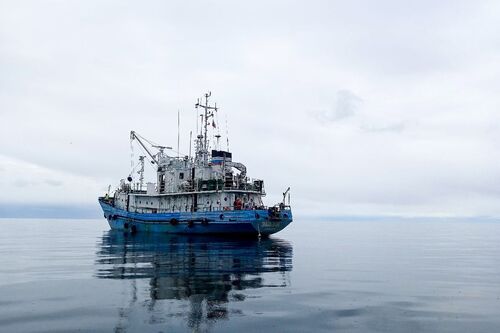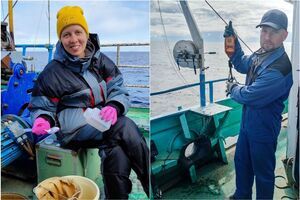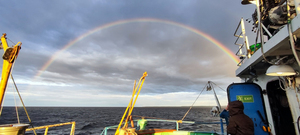The point is that the main feature of deep-water lakes is their heterogeneity in space and time. It is manifest in spring and fall, when two regions sharply different from each other (thermally active and a thermally inert) form inside the water body. The boundary between them is mobile - it is a vertical thermal bar zone, in which the water temperature is 4 ° C from the surface to the bottom.
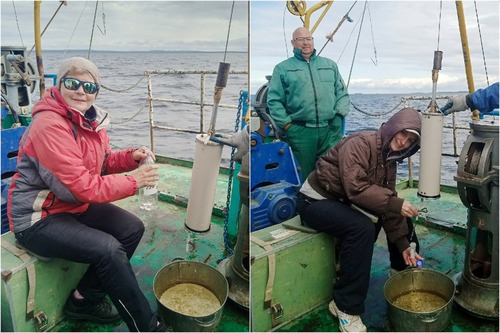
Head of Hydrobiology Laboratory at NWPI KarRC RAS Natalia Kalinkina, Junior Researcher Elena Makarova,
and Senior Researcher Andrey Georgiev in the process of sampling
In spring, near-shore areas are the first to warm up, and it is there that "water blooms" – phytoplankton development – begin, peaking in mid-May-early June. In deeper areas, as the thermobar migrates, these processes occur 1.5-2 months later. This is the natural course of events, but it can be altered if humans intervene.
The spring is a critical period for environmental deterioration in lake areas exposed to pollution. During this period, diatom algae develop intensively as part of phytoplankton in the thermally active region. Their cells have heavy silica walls, so they quickly settle down to the bottom. Normally, their presence is not a concern, but in areas under human impact the levels of such phytoplankton may be very high. Its development augments the input of nutrients, such as nitrogen or phosphorus, into the water. At the same time, the thermal bar, dividing the thermally active region from the central deep-water areas of the lake, promotes the accumulation of pollutants. In spring, substances coming from pollution sources are literally locked up and concentrated in near-shore areas. Phosphorus accumulation stimulates the propagation of diatoms. They actively develop, die back, settle down and accumulate in huge quantities on the bottom, where they are decomposed by bacteria, which intensively consume oxygen. As a result, oxygen-deficient zones can form in the lower water layers in spring. Their formation is fraught with secondary and largely uncontrollable pollution of the lake, when phosphorus will start to rise from the bottom back into the water. This is why it is so important to conduct surveys in spring. This is the time when it is possible to trace the spatial distribution of phytoplankton, which is closely tied to the temperature conditions, and to reveal patterns in the formation of oxygen-deficient zones.
Last year, such surveys were carried out in Petrozavodsk Bay and the central part of Lake Onego; this year they covered Southern, Central and Lesser (Maloye) Onego, as well as Kondopoga Bay, which is affected by wastewater from the Kondopoga pulp and paper mill and by trout farm wastes. Researchers took more than 400 samples at 26 stations to study the temperature conditions, distribution of chlorophyll a concentrations, phytoplankton photosynthesis rate, bacterioplankton and aquatic fungi development indices, oxygen and organic matter content in water.
Targeted study of aquatic fungi is a new trend for the institute. It is the research focus of Elena Makarova, Junior Researcher at the Hydrobiology Laboratory NWPI KarRC RAS. During the expedition, she inoculated water samples on board the ship to check for the presence of aquatic fungi, primarily mold, and then continued this work in the laboratory.
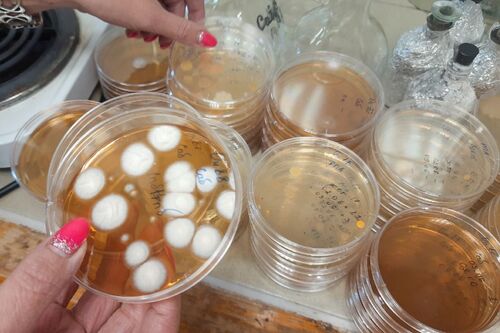
Mold fungi on Petri dishes
– Although the lake has not warmed up yet, the spores of aquatic fungi are already active. We plant them on a nutrient medium to boost their propagation. Fungi are organic matter destructors, they participate in decomposing it, so they are helpers for the lake. Humans, of course, need to boil water before drinking. Mushroom spores are cosmopolitans, present in soil, in air, in water. There is no need to fear these aquatic mold fungi, but it is still better not to drink raw water, - Elena Makarova advised.
At first, scientists intend to study the total abundance of aquatic fungi colonies, and their identification will be done in the next steps.
In addition, specialist took 19 samples of deep-water macrozoobenthos to study the causes of the long-term decline in the numbers of relict crustaceans.
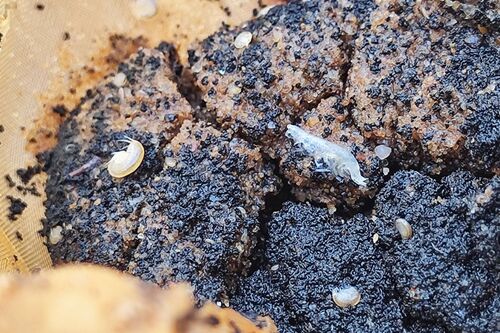
A macrozoobenthos sample, in the photo – deep-water relict crustaceans Monoporeia affinis,
the main food item for whitefishes in Lake Onego
All samples are currently in the final processing stage in laboratories of the Northern Water Problems Institute KarRC RAS.
Speaking specifically about this year, Doctor of Biology Natalia Kalinkina noted that the cold start of the season has left a mark:
– Because of cold weather in late May and early June, thermobar movement has been slow. As a result, we observed vast areas of crystal clear water with minimal color level and chlorophyll amounts in the deepest – central and southern – parts of Lake Onego. This means that the lake has preserved its pristine, extremely valuable clean water. Our task is to conserve it. There are some problem areas however: for example, Kondopoga Bay is affected by trout farms and pulp and paper mill effluents. It is necessary to continue studying the new formation and sedimentation of organic matter and processes in the near-bottom layers, – summarized Natalia Kalinkina.
Hydrobiologists have several more expeditions coming up this season. The results of their research will be reflected in scientific articles and analytical materials for decision-makers.
Photos by E. Makarova, K. Isakova, M. Dmitrieva




